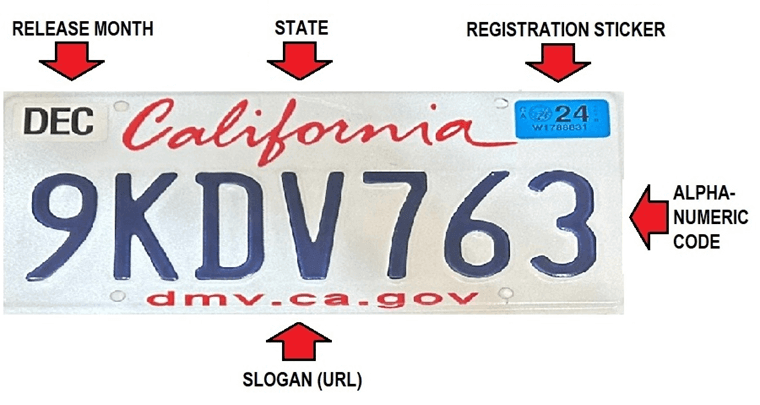Instant California License Plate Lookup —
NMVTIS Data and More
Run a California license plate lookup to get a quick, reliable vehicle history using only the plate number.
California has nearly 36 million registered vehicles (35,983,261 as of Jan 1, 2025). Whether you’re buying a used car in Los Angeles, checking a private sale in San Diego, or inspecting a trade-in in Sacramento, a plate check helps you spot salvage brands, flood damage, odometer issues, and open liens before you commit.
VinAudit matches plates to VINs and returns NMVTIS-backed title events, accident records, reported thefts, historical odometer readings, and lien indicators so you can make smarter buying and selling decisions.
California DMV and License Plate Details
The California Department of Motor Vehicles (DMV) issues and regulates plates, titles, and registration. Services include renewals, title transfers, personalized plates, and registration verification — available online and at field offices across the state.

| Issuing Agency | California Department of Motor Vehicles (DMV) |
| Plate Requirements | Front and rear plates required for most vehicles; rear-only for motorcycles and trailers |
| Plate Validity | Valid for 5 years with current registration stickers |
| Number Format | 6–7 alphanumeric characters (varies by vehicle type) |
| Plate Sizes | Standard: 12″ × 6″; smaller sizes for motorcycles and specialty plates |
| Available Plate Types | Standard, personalized, special interest, legacy, and charity plates |
California Privacy Laws & Owner Information
Owner-identifying information such as names and addresses is protected under the federal Driver’s Privacy Protection Act (DPPA) and California privacy laws. VinAudit provides vehicle history only and does not disclose previous owner names or addresses. For lawful owner-data access, follow DMV procedures or submit an authorized legal request.
How California License Plate Lookup Works
A California license plate lookup links the plate number to the vehicle’s VIN and aggregates official records tied to that VIN. The system then pulls title events, accident reports, theft records, odometer entries, and lien data to build a readable history.
- Enter the plate number and choose California. Type the plate exactly as shown and start the search.
- Match plate to VIN. VinAudit queries DMV-accessible indexes and partner databases to find the VIN associated with the plate.
- Aggregate official records. After a VIN match, the tool pulls NMVTIS, DMV, insurer, and auction records to surface title brands, damage events, reported thefts, and mileage entries.
- Present results with timestamps. Each flagged item shows a timestamp and source so you can evaluate recency and reliability.
What Information You Can Expect To Find
VinAudit’s plate search focuses on vehicle history and condition facts — not personal data. Typical items include:
- Registration state & basic specs: Make, model year, trim, engine, and body style.
- Title branding: Salvage, rebuilt, flood, or other branded titles affecting safety and value.
- Accident & damage records: Reported collisions and insurance claims.
- Odometer & mileage checks: Mileage entries recorded at registration, service, or inspections.
- Theft & recovery flags: Stolen vehicle reports and recoveries.
- Liens & finance encumbrances: Active liens that may affect sale or transfer.
- Market indicators: Estimated resale range and recent sale data when available.
We compile data from NMVTIS, state DMVs, insurers, and auctions. NMVTIS centralizes title brand and key history items to help detect salvage branding and title fraud. Because we rely on official and industry sources, our reports aim to be current and actionable.
How To Use This Page — Step-By-Step
- Enter the exact plate number and make sure “California” is selected.
- See a quick summary and purchase option. Immediately after submission you’ll see basic vehicle specs (make, model, year, trim) and quick flags (salvage, theft, liens) — plus a clear button to purchase a full, NMVTIS-backed report, typically for a fraction of the price of Carfax and other premium providers.
- Run the full report by clicking the CTA; the full report expands title history, accident details, odometer logs, lien records, and source timestamps.
- Review summary flags first (salvage, title brands, theft) — treat these as immediate red flags that need follow-up.
Looking for vehicles in nearby states? Try our Nevada license plate lookup or Oregon license plate lookup.
Verify California Vehicle History by Plate or VIN
Run a California license plate lookup to instantly link a plate to its VIN and surface NMVTIS-backed title brands, accident history, odometer events, and active liens. That fast, evidence-first view helps you spot salvage titles, flood damage, mileage anomalies, and other hidden problems before you buy — saving time and avoiding costly surprises.
Run a VIN check when you have the 17-character VIN for the most complete, granular report: detailed title chain, reported service and auction events, theft/recovery flags, and market-value signals to support pricing and negotiation.
For businesses: Protect your profit margins and reputation by verifying title brands and theft history at scale. VinAudit’s NMVTIS-backed feeds help you stay compliant and avoid acquiring high-risk inventory.
Frequently asked questions (FAQs)
Is it legal to run a license plate search to look up owner’s name and address in California?
How can businesses use California vehicle reports?
How accurate is the CA license plate lookup by VinAudit?
What’s the difference between a license plate check and a VIN check?
